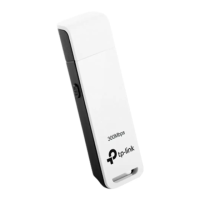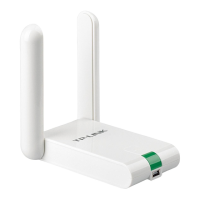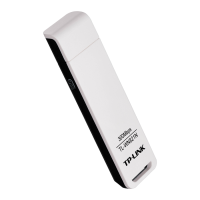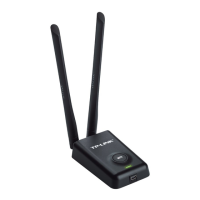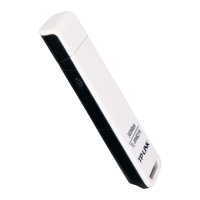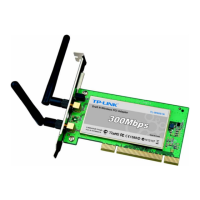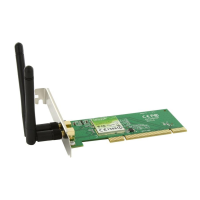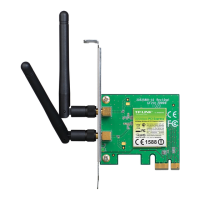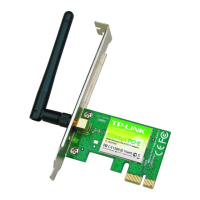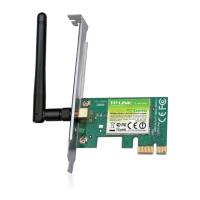Do you have a question about the TP-Link TL-WN823N and is the answer not in the manual?
Details the features and specifications of the wireless adapter, including compliance and throughput.
Explains the meaning of different LED indicator states and provides troubleshooting tips for the adapter.
Instructions on inserting the adapter into a USB port and selecting the appropriate operating system for setup.
Step-by-step guide for installing the driver and utility using the resource CD and setup wizard.
Explains options for connecting to a wireless network using Windows or TP-LINK utilities.
Guide to using the Windows built-in wireless utility for network connection on different OS versions.
Steps to connect to a Wi-Fi network and manage the adapter using the TP-LINK Utility.
Instructions on how to connect to a network using WPS Push Button Configuration or PIN code.
Overview of managing the adapter's connection settings, profiles, and advanced features within the utility.
How to view the adapter's current connection status, IP address, MAC address, and signal strength.
Guide to saving, managing, and joining Wi-Fi networks using connection profiles.
Configuration options for wireless tools, adapter switching, SoftAP, and power saving modes.
How to enable and configure SoftAP mode to create a wireless hotspot.
Procedures for uninstalling the driver and utility software on Windows operating systems.
Step-by-step guide for installing the driver and utility on Mac OS X systems.
Explains options for connecting to a Wi-Fi network on Mac using TP-LINK Utility or WPS.
Guide to connecting to a network using the TP-LINK Utility on Mac.
Instructions for connecting via WPS Push Button Configuration or PIN code on Mac.
Overview of managing Wi-Fi connection settings and profiles using the TP-LINK Utility on Mac.
Steps to uninstall the driver and utility software on Mac OS X systems.
Guide to download and install the compatible driver for Linux from the TP-LINK website.
Provides general safety advice, handling instructions, and product precautions.
Details the features and specifications of the wireless adapter, including compliance and throughput.
Explains the meaning of different LED indicator states and provides troubleshooting tips for the adapter.
Instructions on inserting the adapter into a USB port and selecting the appropriate operating system for setup.
Step-by-step guide for installing the driver and utility using the resource CD and setup wizard.
Explains options for connecting to a wireless network using Windows or TP-LINK utilities.
Guide to using the Windows built-in wireless utility for network connection on different OS versions.
Steps to connect to a Wi-Fi network and manage the adapter using the TP-LINK Utility.
Instructions on how to connect to a network using WPS Push Button Configuration or PIN code.
Overview of managing the adapter's connection settings, profiles, and advanced features within the utility.
How to view the adapter's current connection status, IP address, MAC address, and signal strength.
Guide to saving, managing, and joining Wi-Fi networks using connection profiles.
Configuration options for wireless tools, adapter switching, SoftAP, and power saving modes.
How to enable and configure SoftAP mode to create a wireless hotspot.
Procedures for uninstalling the driver and utility software on Windows operating systems.
Step-by-step guide for installing the driver and utility on Mac OS X systems.
Explains options for connecting to a Wi-Fi network on Mac using TP-LINK Utility or WPS.
Guide to connecting to a network using the TP-LINK Utility on Mac.
Instructions for connecting via WPS Push Button Configuration or PIN code on Mac.
Overview of managing Wi-Fi connection settings and profiles using the TP-LINK Utility on Mac.
Steps to uninstall the driver and utility software on Mac OS X systems.
Guide to download and install the compatible driver for Linux from the TP-LINK website.
Provides general safety advice, handling instructions, and product precautions.
| Interface | WLAN |
|---|---|
| Connectivity technology | Wireless |
| Internal | No |
| Certification | CE, FCC, IC, RoHS |
| Component for | PC/Laptop |
| Product color | Black |
| LED indicators | Status |
| Receiver sensitivity | 300M: -65dBm@10% PER 270M: -65dBm@10% PER 130M: -68dBm@10% PER 108M: -68dBm@10% PER 54M: -72dBm@10% PER 11M: -85dBm@8% PER 6M: -87dBm@10% PER 1M:-93dBm@8% PER |
| Wi-Fi | Yes |
| Modulation | 16-QAM, 64-QAM, CCK, DBPSK, DQPSK, OFDM |
| Wi-Fi band | Single-band (2.4 GHz) |
| Frequency range | 2.4 - 2.4835 GHz |
| Wi-Fi standards | 802.11b, 802.11g, Wi-Fi 4 (802.11n) |
| Top Wi-Fi standard | Wi-Fi 4 (802.11n) |
| Security algorithms | 64-bit WEP, 128-bit WEP, WPA, WPA-PSK, WPA2, WPA2-PSK |
| Networking standards | IEEE 802.11b, IEEE 802.11g, IEEE 802.11n |
| Maximum data transfer rate | 300 Mbit/s |
| WLAN data transfer rates supported | 11, 54, 300 Mbit/s |
| Supported data transfer rates | 11, 54, 300 Mbps |
| Compatible operating systems | Windows XP (32/64-bit) Windows Vista (32/64-bit) Windows 7 (32/64-bit) |
| Storage temperature (T-T) | -40 - 70 °C |
| Operating temperature (T-T) | 0 - 40 °C |
| Storage relative humidity (H-H) | 5 - 90 % |
| Operating relative humidity (H-H) | 10 - 90 % |
| Package depth | 128 mm |
| Package width | 138 mm |
| Package height | 30 mm |
| Package weight | 80 g |
| Depth | 18.3 mm |
|---|---|
| Width | 39 mm |
| Height | 7.9 mm |
